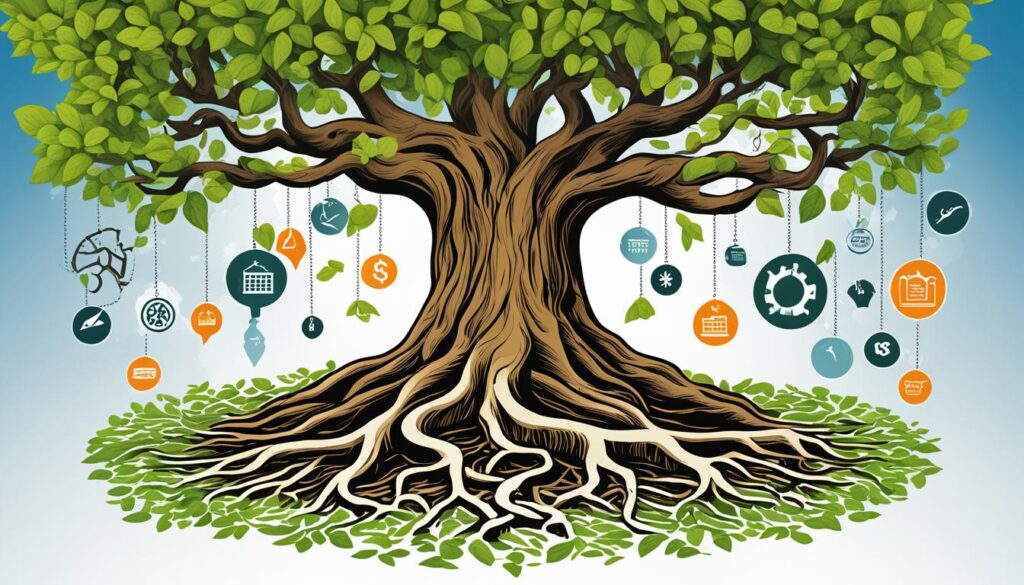Hi there! In this article, I’m going to explain what employee retention is and why it’s so important for businesses today. Whether you’re a small startup or a large corporation, understanding the concept of employee retention can have a significant impact on your overall success.
So, what exactly is employee retention? It refers to an organization’s ability to prevent employee turnover and keep employees in their jobs for a certain period, either voluntarily or involuntarily. Employee retention is a top priority for HR organizations because it directly affects business performance and success.
Recognizing the signs of potential employee turnover is crucial for employers. By understanding what factors contribute to employees leaving their jobs, organizations can develop strategies to increase retention rates and create a more stable workforce.
Key Takeaways:
- Employee retention refers to an organization’s ability to prevent employee turnover and retain employees for a specific period.
- It is a high priority for HR organizations as it directly impacts business performance and success.
- Identifying signs of potential turnover allows employers to take proactive measures to improve retention rates.
- Employee retention strategies focus on addressing common reasons for turnover, such as poor compensation and lack of growth opportunities.
- Higher employee retention rates bring benefits like cost reduction, increased productivity, and improved employee morale.
The Importance of Employee Retention
Employee retention is crucial for businesses due to several key reasons. First, high turnover rates can be costly for organizations. It costs U.S. businesses over $1 trillion a year to replace voluntarily departing employees. Second, employee retention leads to cost reduction, as recruiting and training new employees are expensive. Third, retaining experienced employees can increase productivity and efficiency. Fourth, high retention rates contribute to better employee morale and satisfaction, leading to stronger corporate culture and improved customer experiences. Finally, employee retention can also result in increased revenue and growth for organizations.
“Employee retention leads to cost reduction”
“Retaining experienced employees can increase productivity and efficiency”
“High retention rates contribute to better employee morale and satisfaction”
“Employee retention can also result in increased revenue and growth for organizations”
Strategies for Employee Retention
Organizations can implement various strategies to improve employee retention. By addressing common reasons for employee turnover, such as poor compensation, lack of career development opportunities, work-life balance issues, and discontent with work relationships or company culture, organizations can create a conducive environment for employee satisfaction and longevity.
1. Providing Competitive Compensation and Benefits
Offering competitive salaries, bonuses, and comprehensive benefits packages can incentivize employees to stay with the company. This includes health insurance, retirement plans, paid time off, and other perks that align with industry standards and employee expectations.
2. Creating a Positive Work Environment
A positive work environment fosters employee loyalty and engagement. This can be achieved by promoting open communication, recognizing and valuing diverse perspectives, and encouraging collaboration and teamwork. Additionally, offering opportunities for social interaction and team-building activities can contribute to a positive and supportive workplace culture.
3. Offering Opportunities for Professional Growth and Development
Investing in employees’ professional growth not only enhances their skills and knowledge but also demonstrates the organization’s commitment to their long-term success. Providing training programs, mentorship opportunities, and career advancement paths can motivate employees to stay and contribute to their professional development.
4. Recognizing and Rewarding Employee Achievements
Recognizing and rewarding employee achievements can boost employee morale and motivation. This can be done through formal recognition programs, employee of the month awards, performance-based bonuses, or other forms of acknowledgment that show appreciation for their hard work and dedication.
5. Promoting Work-Life Balance
Encouraging work-life balance is essential for employee retention. Implementing flexible work arrangements, offering paid parental leave, supporting employee well-being initiatives, and promoting a healthy work-life integration can help employees maintain a healthy work-life balance and reduce the risk of burnout.
6. Fostering Strong Relationships between Employees and their Supervisors
Effective leadership and positive relationships between employees and their supervisors significantly contribute to employee satisfaction and retention. Encouraging regular feedback, providing opportunities for professional development discussions, and creating a supportive work environment can foster strong bonds and trust between employees and their supervisors.
7. Implementing Employee Retention Programs
Employee retention programs are comprehensive initiatives designed to identify and address potential reasons for turnover. These programs may include ongoing employee engagement surveys, career development plans, mentorship programs, employee assistance programs, and other proactive measures to retain top talent within the organization.
By implementing these strategies, organizations can enhance their employee retention rates, create a positive work culture, and secure a competitive advantage in attracting and retaining talented employees.

Benefits of Employee Retention
Employee retention brings several benefits to organizations. Firstly, it reduces costs associated with recruiting and training new employees, which can range from 90% to over 200% of an employee’s salary. This cost reduction can significantly impact an organization’s bottom line, allowing them to allocate resources more efficiently.
Secondly, employee retention improves productivity. Experienced employees who have been with the company longer are often more efficient and produce higher-quality outputs. This increased productivity translates into better business results and a competitive advantage in the market.
Thirdly, employee retention boosts employee morale and satisfaction. When employees feel valued and supported by the organization, they are more engaged and motivated to perform at their best. This positive employee experience leads to higher job satisfaction and lower turnover rates.
Fourthly, employee retention preserves institutional knowledge. Long-term employees have a deeper understanding of the organization’s processes, culture, and customer needs. This institutional knowledge is invaluable and can help drive innovation, improve customer relationships, and ensure smoother operations.

In summary, higher employee retention rates can have a positive impact on revenue and business growth, while also reducing recruitment and training costs. However, organizations may face challenges in achieving and maintaining high employee retention rates due to competition for top talent, changing workforce demographics, and evolving employee expectations. By implementing effective retention strategies and addressing these challenges, organizations can create a loyal and engaged workforce that contributes to long-term success.
Conclusion
Employee retention is a crucial aspect for any successful business. By understanding the concept of employee retention, recognizing its importance, implementing effective strategies, and reaping the benefits, organizations can create a positive work environment and foster long-term success.
To improve employee retention, organizations should focus on several key tips. Firstly, offering competitive compensation and benefits is essential in attracting and retaining top talent. Secondly, providing growth opportunities, such as training and career development programs, can increase employee satisfaction and commitment to the organization.
Promoting work-life balance is also crucial in employee retention. Employees who have a healthy work-life balance are more likely to stay with an organization for the long term. Additionally, enhancing employee engagement and recognition can significantly impact retention rates. Recognizing and rewarding employee achievements helps to create a positive and motivating work atmosphere.
Finally, cultivating a positive company culture is vital in retaining employees. Organizations that foster a supportive and inclusive culture have higher employee satisfaction and lower turnover rates. By implementing these tips, organizations can retain their top talent, reduce turnover, and position themselves for long-term success.
FAQ
What is employee retention?
Employee retention refers to an organization’s ability to prevent employee turnover and keep employees in their jobs for a certain period. It can be either voluntarily or involuntarily.
Why is employee retention important?
Employee retention is important for several reasons. It reduces costs associated with turnover, improves productivity and employee morale, preserves institutional knowledge, and contributes to revenue and business growth.
What strategies can organizations implement for employee retention?
Organizations can implement various strategies for employee retention such as offering competitive compensation and benefits, creating a positive work environment, providing growth opportunities, recognizing and rewarding employee achievements, promoting work-life balance, fostering strong relationships between employees and supervisors, and implementing employee retention programs.
What are the benefits of employee retention?
Employee retention brings several benefits to organizations, including cost reduction, increased productivity, improved employee morale and satisfaction, preservation of institutional knowledge, and potential revenue and business growth.
Any tips for employee retention?
To improve employee retention, organizations should focus on providing competitive compensation, offering growth opportunities, promoting work-life balance, enhancing employee engagement and recognition, and cultivating a positive company culture.





